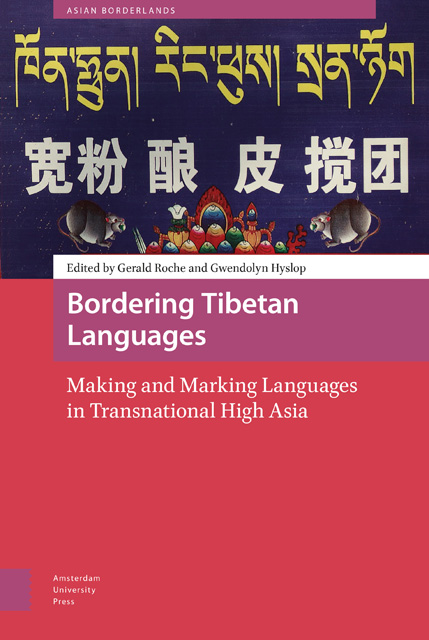Book contents
- Frontmatter
- Table of Contents
- Acknowledgements
- About the Cover Image
- 1 Introduction: Bordering Tibetan Languages: Making and Marking Languages in Transnational High Asia
- 2 Playing with Language Boundaries: Heteroglot Standard Language Ideology and Linguistic Belonging among Amdo Children
- 3 The Role of Classical Tibetan (Chöke) on the Development of Kurtöp, a Language of Bhutan
- 4 Reimagining Rongring without Tibetan Buddhist Influence
- 5 Glottonyms, Identity, and Language Recognition in the Eastern Tibetosphere
- 6 On the Yak Horns of a Dilemma: Diverging Standards in Diaspora Tibetan
- 7 Changing Identity and Linguistic Practices in Nubri: Veiled Language Endangerment in the Nepalese Tibetosphere
- 8 Borderline Dominance: Transnational Tibetan Language Politics in the Himalayas
- 9 Borders: In Conclusion
- Tibetan Language Summaries
- Asian Borderlands
- Index
4 - Reimagining Rongring without Tibetan Buddhist Influence
Published online by Cambridge University Press: 24 November 2022
- Frontmatter
- Table of Contents
- Acknowledgements
- About the Cover Image
- 1 Introduction: Bordering Tibetan Languages: Making and Marking Languages in Transnational High Asia
- 2 Playing with Language Boundaries: Heteroglot Standard Language Ideology and Linguistic Belonging among Amdo Children
- 3 The Role of Classical Tibetan (Chöke) on the Development of Kurtöp, a Language of Bhutan
- 4 Reimagining Rongring without Tibetan Buddhist Influence
- 5 Glottonyms, Identity, and Language Recognition in the Eastern Tibetosphere
- 6 On the Yak Horns of a Dilemma: Diverging Standards in Diaspora Tibetan
- 7 Changing Identity and Linguistic Practices in Nubri: Veiled Language Endangerment in the Nepalese Tibetosphere
- 8 Borderline Dominance: Transnational Tibetan Language Politics in the Himalayas
- 9 Borders: In Conclusion
- Tibetan Language Summaries
- Asian Borderlands
- Index
Summary
Abstract
This chapter focuses on Rongring – a language spoken by Lepchas in the eastern Himalayan borderlands. It focuses on language contact via Tibetan Buddhist religion and the borrowing of words, terminologies and ideas into the Lepcha language, including the creation of a new script. This process led to the blurring of linguistic borders between Lepcha speakers and Tibetan speakers, This chapter examines this process and questions whether it is possible to imagine Lepcha language without borrowed lexicons and traditions from Tibetan Buddhism vis-à-vis the Tibetan language. In the context of the often hazy borders between the Lepcha and Tibetan languages, this chapter attempts to trace the historical importance of Tibetan Buddhism in the development of Lepcha language as we know it today.
Keywords: Rongring, Lepcha language, Tibetan Buddhist, influence
Introduction
The Buddhist monks were keen to communicate with the Lepcha people in their own language, and as so often happens when the influence of a new religion spreads, religious texts were translated into the local language of the area, in this case Lepcha, for which an alphabet had yet to be created.
– Plaisier (2006, p. 34)The Lepchas are the Indigenous people of Sikkim and the Darjeeling hills in India. They reside in small numbers in eastern Nepal and south-west Bhutan as the total Lepcha population is reported to be less than a lakh (100,000) across the world. Prior to the formation of nation states, Lepchas called their country Mayel Lyang – the land of hidden paradise – which, according to their oral history, included the above-mentioned territories and more when mapped out. While scholars have discarded this imagined ‘homeland’ for the Lepchas because there is no historical evidence supporting this view – it is “not dependent academically” (Subba, 1985) – there is a Lepcha song about the mythical homeland that tells us otherwise.
Chuk-lat, Ponoke take,
Chuk-kyer, Ru-chang Rang-a-Dake,
Chuk-gyom Tal, Chyu-bee Bong,
Chuk-veem, Zo-la-see Brong
Foning (1987) interprets these lines as the traditional territories of Mayel Lyang, where Chuk-lat in the first stanza means ‘east’ and Po-nok is thought to be Punakha, which is the former capital of Bhutan.
- Type
- Chapter
- Information
- Bordering Tibetan LanguagesMaking and Marking Languages in Transnational High Asia, pp. 83 - 104Publisher: Amsterdam University PressPrint publication year: 2022



